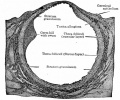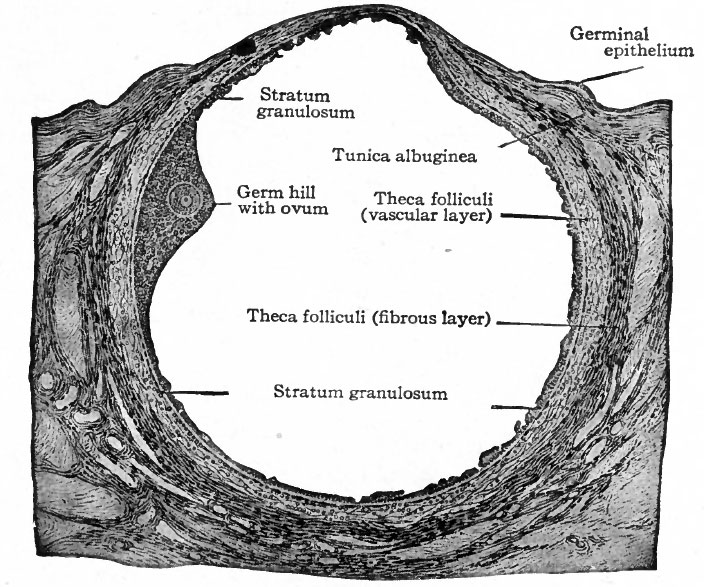File:Bailey014.jpg
Bailey014.jpg (704 × 587 pixels, file size: 116 KB, MIME type: image/jpeg)
Fig. 14. From section of human ovary, showing mature Graafian follicle ready to rupture
When the Graafian follicle is mature, having reached its maximum size, it produces a bulge on the ovary; and there is only a thin membrane, composed of the granular layer, the theca and the germinal epithelium of the ovary, between the follicular cavity and the exterior of the ovary (Fig. 14). At a certain time this membrane breaks and the follicular fluid gushes out, carrying with it the ovum and some of the cells of the germ hill. The ovum is then free in the abdominal cavity whence normally it passes into the open end of the oviduct, or Fallopian tube. The cause of the rupture of the follicle has not been ascertained; but there are certain facts which throw light upon it. In the dog ovulation occurs during oestrus, or the period of "heat," independently of approach of the male. In the mouse, the rat and the guinea-pig ovulation also occurs spontaneously during oestrus. In the rabbit ovulation occurs about ten hours after coitus, and it has been shown experimentally that the follicle does not rupture after any stimulus except coitus. The sheep ovulates spontaneously during the earlier "heat "periods of the breeding season, but in the later periods coitus seems necessary to bring about the rupture of the follicle. In the bat, however, there are peculiar circumstances: Copulation takes place in the autumn, the spermatozoa remaining alive in the uterus until the following spring, and then ovulation occurs apparently in response to seasonal temperature changes without even a "heat" period. These are only a few instances out of a great number of observations, but they show that in general ovulation occurs during the oestrus or period of "heat" in the female, sometimes coincident with copulation. Just prior to the oestrus period there is a marked increase of blood flow to the generative organs, during a pro-cestrual period or pro-cestrus. During oestrus the increased blood flow is maintained and may be accentuated at the approach of the male, and it has been suggested that an increase in blood pressure in the ovary is at least one of the factors in causing the rupture of the Graafian follicle. Another contributing factor may be an increase in the quantity of fluid within the follicle thereby increasing the intrafollicular pressure.
- Text-Book of Embryology: Germ cells | Maturation | Fertilization | Amphioxus | Frog | Chick | Mammalian | External body form | Connective tissues and skeletal | Vascular | Muscular | Alimentary tube and organs | Respiratory | Coelom, Diaphragm and Mesenteries | Urogenital | Integumentary | Nervous System | Special Sense | Foetal Membranes | Teratogenesis | Gallery of All Figures
| Historic Disclaimer - information about historic embryology pages |
|---|
| Pages where the terms "Historic" (textbooks, papers, people, recommendations) appear on this site, and sections within pages where this disclaimer appears, indicate that the content and scientific understanding are specific to the time of publication. This means that while some scientific descriptions are still accurate, the terminology and interpretation of the developmental mechanisms reflect the understanding at the time of original publication and those of the preceding periods, these terms, interpretations and recommendations may not reflect our current scientific understanding. (More? Embryology History | Historic Embryology Papers) |
Reference
Bailey FR. and Miller AM. Text-Book of Embryology (1921) New York: William Wood and Co.
Cite this page: Hill, M.A. (2024, April 19) Embryology Bailey014.jpg. Retrieved from https://embryology.med.unsw.edu.au/embryology/index.php/File:Bailey014.jpg
- © Dr Mark Hill 2024, UNSW Embryology ISBN: 978 0 7334 2609 4 - UNSW CRICOS Provider Code No. 00098G
File history
Click on a date/time to view the file as it appeared at that time.
| Date/Time | Thumbnail | Dimensions | User | Comment | |
|---|---|---|---|---|---|
| current | 14:37, 17 January 2011 |  | 704 × 587 (116 KB) | S8600021 (talk | contribs) | {{Template:Bailey 1921 Figures}} |
You cannot overwrite this file.
File usage
The following 4 pages use this file:

